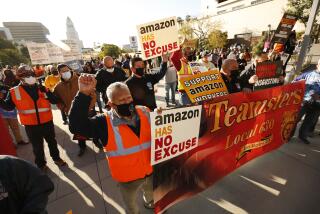Workers Now Competitive, but Managers?
- Share via
Is it cause for rejoicing or regret that every new labor cost statistic shows U.S. industry to be increasingly competitive?
U.S. wages are now below those of West Germany and Japan and getting down to those of France and Italy, because the dollar’s decline boosts foreign labor costs. That is, the 3,000-yen per hour Japanese factory worker made the equivalent of $12 an hour when 250 yen equaled $1, but now makes $24 an hour because 125 yen equal $1. Sure, it’s still 3,000 yen in Japan. But it’s a boost in labor costs if that worker makes something to be sold in the United States--as 70% of Japanese workers do.
But U.S. labor costs have been falling aside from the currency shift. The President’s Economic Report to Congress this year shows that hourly earnings in U.S. industry are now 94% of what they were in 1977--adjusted for inflation.
So U.S. workers are definitely competitive. But are they poorer?
No, say the scholars, because the standard of living the U.S. worker can buy with his or her dollar is still higher than what the Japanese worker can buy with his yen or the German worker with his mark. The concept is purchasing power parity, explains Robert Lipsey, economics professor at New York’s Queens College, and it focuses on what is affordable to the average worker.
In the United States, a bigger house is affordable to more people, for example, and food is cheaper. “I think Germany is 10% to 15% below U.S. levels in purchasing power,” says Lipsey, “while Japan is 20% to 25% below.”
So we can count our blessings--but also continue our worries.
That’s because there are doubts that U.S. industry can really become competitive by lowering the working stiff’s wage alone. And those doubts are reinforced by the record of America’s corporate chieftains, whose average income was $651,000 a year ago, according to Business Week, and has continued to rise faster than the cost of living or even company profits.
Diminishing Returns
Does pay reflect competitiveness? Are U.S. firms more venturesome than Japanese ones? The question is laughable. Even believers in the Easter Bunny have doubts about U.S. management.
The pay is a lingering effect of ideas first tried 60 years ago to unite managers’ interests with those of the shareholders through high salaries and stock options.
But now the idea is bringing diminishing returns, as managers mindful of shareholders’ immediate interests make dumb decisions about a business’s long-term potential--and make a lot of people worried about their jobs.
It’s part of a larger problem, says Frank Levy of the University of Maryland, author of “Dollars and Dreams,” a book about income distribution. The college-educated person has gained in this decade, Levy says, “but the high school graduate has lost out.”
Levy expresses incomes in inflation-adjusted 1984 dollars to make a stark comparison. “In 1973, the 30-year old male high school graduate made $22,000, today he makes $17,500,” he says--and suggests that’s where resentment in the political campaign is coming from.
Meanwhile, a move to raise the minimum wage from $3.35 an hour to $5.05 is being opposed by a broad cross section of U.S. business.
Is competitiveness really threatened by an extra buck for low wage workers? No, says Peter F. Drucker, the industrial expert. It’s not low wages but trained workers and sophisticated machinery that make industry competitive today.
Robert Collins, who heads North American operations for GE-Fanuc Automation--the joint venture between General Electric and Fanuc of Japan in factory equipment--seconds the motion. With workers trained to handle the new computerized machinery, says Collins, “you can produce just about anything in this country at quality as good as anywhere in the world.”
Such trained workers don’t make less money, they make more. And furthermore, they can be pretty sure of their jobs--as foreign companies build U.S. factories.
The point is, future competition is going to be different--not simply a battle against imports. Instead, more goods will be produced in the United States, but not always by U.S.-owned companies.
And that will test whether highly paid U.S. managers are as competitive as U.S. workers.
More to Read
Inside the business of entertainment
The Wide Shot brings you news, analysis and insights on everything from streaming wars to production — and what it all means for the future.
You may occasionally receive promotional content from the Los Angeles Times.










